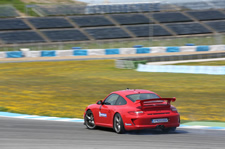Introduction
 |
You very quickly realise the importance of tyres when you start doing track days, as they play a vitally important part in getting you round the circuit quickly, safely and consistently. If you make a poor tyre choice, or use your tyres incorrectly, this can drastically reduce your performance and even affect your safety on the track.
Car manufacturers’ tyre pressure recommendations are normally based on “cold” tyres, but on a track day you also need to monitor your pressures once your tyres are up to temperature in the “hot” condition. This is because track use generates much higher tyre temperatures than road use. This extra heat this leads to an increase in tyre pressure, meaning that bleeding some air out of the tyres during the track day may avoid excessive over-inflation. |
When you get to the track, regular track day goers may know what tyre pressure they normally start the day at. If this is not known, start the day with the car’s standard tyre pressures, with a view to monitoring the pressures when the tyres are “hot”.
Generally, for road tyres, the optimum “hot” track pressures will be higher than the standard recommended pressures, typically by around 6 psi.
 |
Heavier cars tend to need a greater increase over the standard pressures than lighter cars. If your tyre pressures are too low, this can lead to excessive flexing of the sidewall, a sensation of sponginess, a lack of steering response and abnormal wear. Pressures that are too high can lead to reduced grip, light steering, and even localised overheating.
Tyres run cooler in wet conditions, so if it is wet, you can start at your car maker’s recommended pressures, and little adjustment will be required while these conditions last. |
At the end of the day, and once your tyres have cooled down, you must re-set (usually re-inflate) your tyres to the car maker’s recommended pressures before driving on the road.
If you are a regular track day goer using slick or semi-slick tyres, you can consider measuring your tyre tread temperatures to assist in suspension and tyre pressure set up. Motorsport teams use this technique to optimise vehicle performance, but it may be a step too far for the average track day enthusiast.
Handling
The tyre, is a vital component with a large influence in your vehicle’s handling.
Handling performance refers to the way in which the vehicle/tyre responds to the many demands of the driver, such as steering, accelerating and braking.
- Handling development is particularly complex as it depends on a range of factors at three different levels, namely:
- The vehicle (geometry and weight distribution)
- The elements involved in ground/vehicle contact (tyres, steering and suspension),
- The driving assistance systems (stability control and the steering axle).
The tyre plays a key role in road holding because it is at the end of the chain, it ensures the transmission of the efforts between the vehicle and the ground to maintain the trajectory defined by the driver.
Track Tyre Checklist
Check your tyres before you set out – correct size/type, pressures, damage, tread depths
- Will you have sufficient tread depth for the journey home after your track work?
- Monitor your tyres’ hot pressures, and keep an eye on tyre condition throughout the day.
- Remember to use the normal road pressures on the road once the track session is over.
- Always fit valve caps. This is the primary seal and prevents dirt entering the valve.
A little bit of Michelin
Michelin set a new world record for electric vehicles under 1000kg with Drayson Racing.
Following the partnership between Drayson Racing Technologies and Michelin, Lord Drayson was successful in his bid to break the World Electric Land Speed Record for a car under 1,000kg by posting an average of 204.185mph over two runs completed within one hour.
Michelin's LMP1 tyres helped Audi to victory in the 90th Le Mans 24 hour race, the second in a row for a hybrid car, and same tyre specification was used by Drayson Racing's electric race car to a new electric land speed record.
The Drayson B12 69/EV electric Le Mans Prototype smashed the previous 175mph record, which had stood for 40 years, by 29.2mph.
The tyre design needed to offer:
- Low rolling resistance to reduce battery drain
- High traction levels to enable the car to accelerate to maximum speed as quickly as possible
- Good stability to enable the car to safely run with minimal down-force hence reduce drag
- Excellent braking performance to ensure the car could be stopped safely before the end of the runway.
 |
A Final Thank You and Congratulations
You have now come to the end of the Tyre Academy program, CONGRATULATIONS. We hope you have enjoyed your learning and feel that you have gained valuable and beneficial knowledge.
Your final task is to complete the level 3 quiz and you’re all done!
|
|

